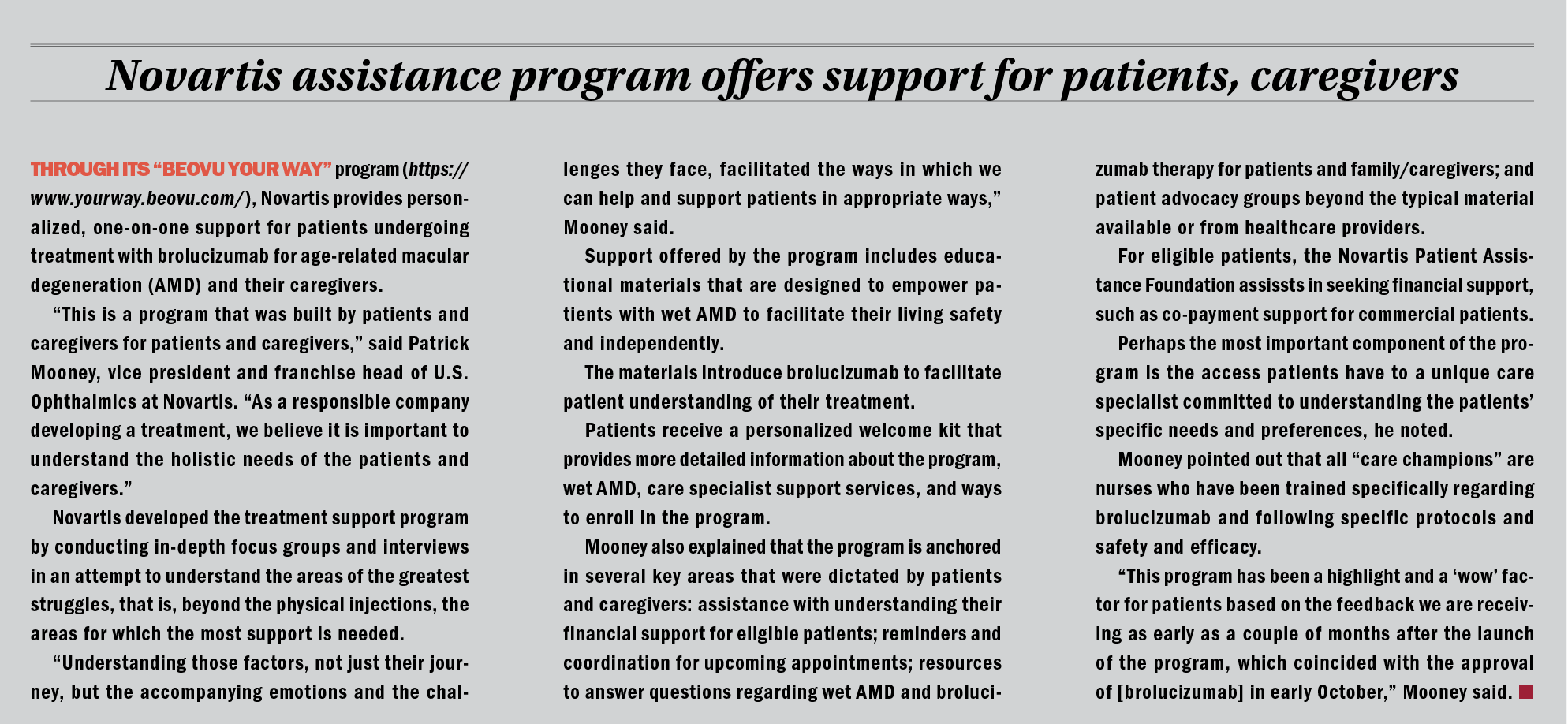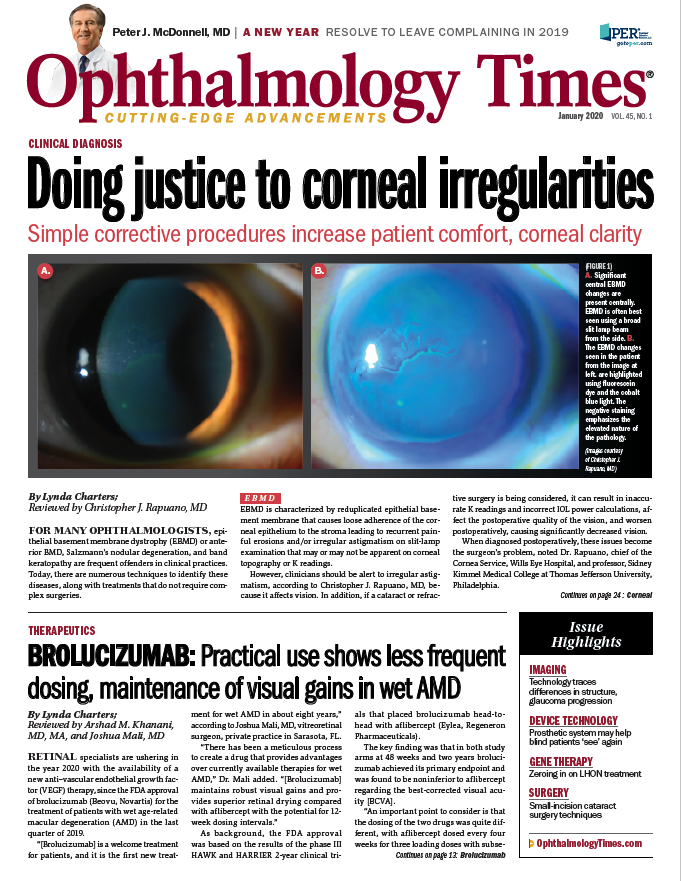News
Article
Digital Edition
Brolucizumab: Less frequent dosing/maintenance of robust visual gains in wet AMD
Author(s):

This article was reviewed by Arshad M. Khanani, MD, MA, and Joshua Mali, MD
Retinal specialists are ushering in the year 2020 with the availability of a new anti–vascular endothelial growth factor (VEGF) therapy, since the FDA approval of brolucizumab (Beovu, Novartis) for the treatment of patients with wet age-related macular degeneration (AMD) in the last quarter of 2019.
“[Brolucizumab] is a welcome treatment for patients, and it is the first new treatment for wet AMD in about eight years,” according to Joshua Mali, MD, vitreoretinal surgeon, private practice in Sarasota, FL.
“There has been a meticulous process to create a drug that provides advantages over currently available therapies for wet AMD,” Dr. Mali added. “[Brolucizumab] maintains robust visual gains and provides superior retinal drying compared with aflibercept with the potential for 12-week dosing intervals.”
As background, the FDA approval was based on the results of the phase III HAWK and HARRIER 2-year clinical trials that placed brolucizumab head-to-head with aflibercept (Eylea, Regeneron Pharmaceuticals).
The key finding was that in both study arms at 48 weeks and two years brolucizumab achieved its primary endpoint and was found to be noninferior to aflibercept regarding the best-corrected visual acuity [BCVA].
“An important point to consider is that the dosing of the two drugs was quite different, with aflibercept dosed every four weeks for three loading doses with subsequent extension to every eight weeks,” according to Mali, who is also founder and chief executive officer of Mali Enterprises. “In contrast, brolucizumab was dosed every four weeks for three loading doses and then extension to every eight or potentially 12 weeks based on the assessment of the disease activity.”
Other relevant findings, Dr. Mali pointed out, were that the visual gains achieved with brolucizumab were noninferior to those achieved with aflibercept at the two time points with longer treatment intervals in most patients; about 56% of patients in the HAWK trial and 51% in the HARRIER being treated with brolucizumab were maintained on three-month dosing during the first year.
In addition, the central retinal thickness in patients receiving brolucizumab in both study arms decreased more compared with aflibercept at both week 16 and years one and two, he noted.
“Retinal fluid is a critical indicator of disease activity in patients with wet AMD and how they are responding to treatment,” he said. “The presence of fluid is also an extremely important factor in the determination of BCVA.”
Safety profiles of the two drugs were similar. A difference was seen in inflammation between brolucizumab and aflibercept, 4% and 1%, respectively.
Impact in clinical practice
Brolucizumab is a single-chain antibody fragment and is a smaller molecule compared with other anti-vascular endothelial growth factor (VEGF) formulations that are currently available, according to Arshad M. Khanani, MD, MA, clinical associate professor, University of Nevada, Reno School of Medicine.
“The small size of the molecule and the 6-mg injection results in a relative molar dosing of about 12 times compared with aflibercept,” Dr. Khanani said. “This is what accounted for the greater drying of the retina compared with aflibercept in the HAWK and HARRIER phase III studies.”
For Dr. Khanani, perhaps the greatest impact brolucizumab will have for both patients and physicians is a substantially reduced treatment burden.
“Patients with neovascular AMD require treatment anywhere from every four to eight weeks,” he said. “When considering the real-world outcomes, the gains in vision are minimal, about eight to 12 letters, compared with the results in the clinical trials. This speaks to the unmet need for durable agents that last longer to decrease the treatment burden.”
Another factor, he noted, is many patients still have active disease despite monthly injections. These patients have persistent fluid and a high need for anti-VEGF therapy. Two weeks after an injection the retina is dry, but by four weeks, the fluid returns.
“Having a more potent drug to control the disease in a patient with a higher VEGF load is a big advantage,” he said.
In his clinical practice brolucizumab fulfills two needs for patients, Dr. Khanani noted. He starts treatment-naïve patients with the more durable brolucizumab to control the disease for a longer period. For his previously treated patients who have persistent fluid on monthly injections, they can be switched to brolucizumab to dry the retina and better control the disease
Patients receive three loading doses of the drug followed by two doses at 8 or 12 weeks based on the HAWK and HARRIER trials.
“Even if a patient had been previously treated for AMD, they can be treated according to this schedule, but they may not need the loading doses if the retina is dry after one injection,” Dr. Khanani said.
Dr. Khanani has not seen any significant adverse events in patients that he has treated so far in the brolucizumab clinical trials or in his clinic after approval. He is, however, aware of higher rates of inflammation in the brolucizumab-treated patients in the HAWK and HARRIER studies.
“As with any new drug, we need to watch for any adverse events that can develop in patients who are receiving treatment,” he said.
Patients are encouraged about the increased time between treatments, thus lessening the burden on them and their families, he noted.
“We have not had a new drug for these patients since 2011 when aflibercept was approved. It is exciting for our patients and for physicians to have this new drug that is more durable than the available drugs and achieves better drying of the central retina and better control,” Dr. Khanani concluded.
Beovu was granted a Permanent J code that began Jan. 1, 2020.

Arshad M. Khanani, MD, MA
E: Arshad.Khanani@gmail.com
Dr. Khanani is a consultant andn speaker for Novartis and receives research funding from Novartis.Joshua Mali, MD
E: malienterprisesglobal@gmail.com
Dr. Mali is a consultant to and receives speaker honoraria from Novartis. He previously was a speaker for and received funding from Regernon Pharmaceuticals.
Newsletter
Don’t miss out—get Ophthalmology Times updates on the latest clinical advancements and expert interviews, straight to your inbox.






